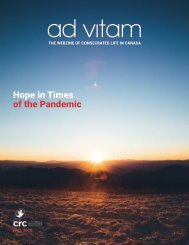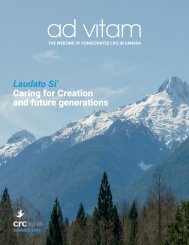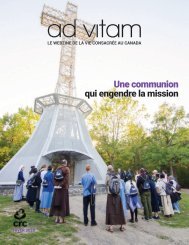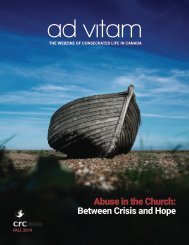ad vitam - Winter 2020
READING TIPS The ad vitam webzine is unique in its offer of an integral and interactive experience featuring articles and audio-visual content. We strongly suggest that you read it online, ideally on a computer or tablet (not recommended on a smartphone). To zoom in: on a computer, double-click or use the + and - found at the bottom-right of the screen; on a tablet, double-tap the screen. Use your mouse or finger to move throughout the page. It is possible to download a PDF of the webzine, however the file will not support links and audio-visual content. For environmental reasons, we invite you to limit printing of the PDF. You may contact us if you wish to obtain a text-only version of a specific article. We hope that as you acquaint yourself with our webzine over time, you’ll enjoy the enriching experience of its unique format. We welcome your comments and questions at info@crc-canada.org.
READING TIPS
The ad vitam webzine is unique in its offer of an integral and interactive experience featuring articles and audio-visual content. We strongly suggest that you read it online, ideally on a computer or tablet (not recommended on a smartphone). To zoom in: on a computer, double-click or use the + and - found at the bottom-right of the screen; on a tablet, double-tap the screen. Use your mouse or finger to move throughout the page.
It is possible to download a PDF of the webzine, however the file will not support links and audio-visual content. For environmental reasons, we invite you to limit printing of the PDF. You may contact us if you wish to obtain a text-only version of a specific article. We hope that as you acquaint yourself with our webzine over time, you’ll enjoy the enriching experience of its unique format. We welcome your comments and questions at info@crc-canada.org.
Create successful ePaper yourself
Turn your PDF publications into a flip-book with our unique Google optimized e-Paper software.
When an encounter with God is called an “ecstasy”, it<br />
is because it takes us out of ourselves, lifts us up and<br />
overwhelms us with God’s love and beauty. Yet we can also<br />
experience ecstasy when we recognize in others their hidden<br />
beauty, their dignity and their grandeur as images of God<br />
and children of the Father. The Holy Spirit wants to make<br />
us come out of ourselves, to embrace others with love and<br />
to seek their good. That is why it is always better to live the<br />
faith together and to show our love by living in community<br />
and sharing with other young people our affection, our time,<br />
our faith and our troubles. The Church offers many different<br />
possibilities for living our faith in community, for everything<br />
is easier when we do it together.<br />
Post-synodal Apostolic Exhortation Christus vivit, no. 164.<br />
gaze, we experience the love of the Most Holy<br />
Trinity.” 4<br />
In and through an encounter with Jesus we<br />
are able to glimpse something of the merciful<br />
love of the Trinity. God is a dynamic reality of<br />
relations, Father, Son and Holy Spirit, and the<br />
work of divine freedom unfolds as the Father’s<br />
personal freedom begets the eternal Son, the<br />
inseparable Other and together the Father<br />
and the Son breathe out the eternal Spirit. The<br />
Father `has’ nothing apart from what he `is’, so<br />
his gift to the Son is an act of total `self-expropriation’.<br />
The Son is the perfect image of the<br />
Father, who returns the Father’s self-gift in an<br />
act of thanksgiving that likewise involves his<br />
whole self. And the Spirit is the fruitfulness of<br />
this mutual gift that always exceeds and overflows.<br />
The mystery of our Triune God involves<br />
one God in three persons, but the persons are<br />
only distinct in their relating. Accordingly, from<br />
eternity there is a relationship of communion<br />
(one God) and otherness (three persons) within<br />
the Trinity. God is not first one and then<br />
three but simultaneously both – otherness is<br />
inconceivable apart from relationship - and<br />
therefore it is revealed that communion does<br />
not threaten otherness rather it generates<br />
it. 5 This co-inherence of unity and otherness<br />
stands in sharp contr<strong>ad</strong>iction to our contemporary<br />
culture, where ‘otherness’ is often seen<br />
as at best suspicious and at worse a positive<br />
threat.<br />
Fear of the Other<br />
Within our world today there is an impetus to<br />
regard the other as our enemy until proven to<br />
be a friend. Christian tr<strong>ad</strong>ition ascribes this attitude<br />
to the result of the ‘Fall’ and it does appear<br />
that there is – as it were – a form of pathology<br />
inherent in our genes that is the fear of the<br />
other. Clearly this is inculcated from an early<br />
age when we warn young children for their protection<br />
to be wary of strangers. Yet when the<br />
AD VITAM • WINTER <strong>2020</strong> • 5










